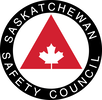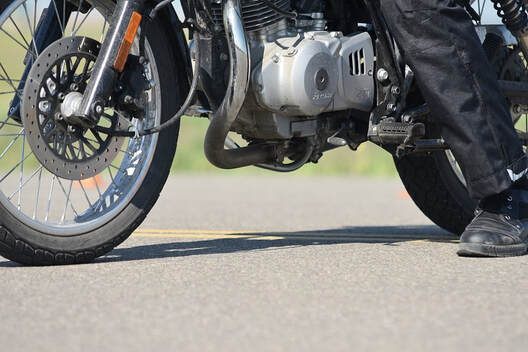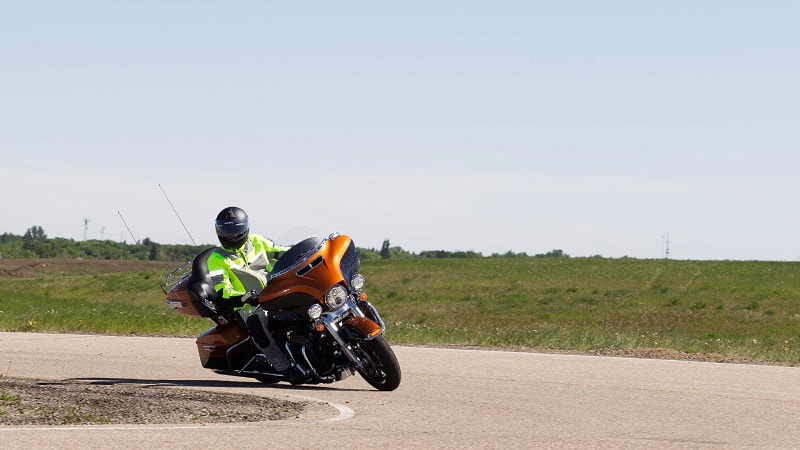|
Saskatchewan's great spring awakening is underway. Have you peeled off the tarp and tuned up your two-wheeler for the spring riding season? Let's take a look at what hazards might await you on that first trip out of the garage. Does this springtime road hazard look familiar? Yes, under all that melting snow lies the classic motorcycle nemesis - sand and gravel. Especially on urban roads, these slippery hazards can wreak havoc on your traction, and are hard to spot from a distance. Let's go over some facts about these sandy patches that await Saskatchewan riders in the spring. First off, what does a slippery surface do to our tires? In our Basic Rider Training Course, riders learn that friction is our friend, with the force of friction directly proportionate to the applied load, or weight. The lesson here is more weight = more friction, and more friction = better traction. So, what happens to our bike when a slippery patch ruins our traction? The answer is.... Anything. If we are leaning into a corner and lose that critical friction, there is no telling what the bike will do. At that point, we are trying to avoid abrupt or sudden changes in weight distribution. The best course of action in this situation is to do more of 'nothing' than trying to do 'everything'. Do nothing... That doesn't sound like very useful advice, does it? As per usual, prevention is the name of the game when it comes to managing dirt and sand. And it may seem obvious, but speed really is the key here. Our friends at SGI lay out this advice for motorcyclists entering corners:
1. Reduce Speed. To make up for the possible lack of friction, reducing speed puts your bike's weight back in balance over both tires. 2. Avoid Sudden Moves. Sudden changes in speed or direction rock that weight back and fourth over the tires, which leads to a skid. 3. Use Both Brakes. Using both brakes in a straight line is the most effective way to stop in the shortest distance. If you are in a turn/corner be very careful when using the front brake, as the wheel could slip right out and cause you to go down. 4. Avoid the Worst Slippery Areas. Easier said than done! Try to find the best pavement, and use it. Certain sections of the road dry out faster than others. Try to stay in the best part of the lane at all times. Some extra facts to help your early season moto-mindset:
Got some sand and gravel tips? What other springtime hazards should motorcyclists be aware of? Help other riders by leaving a comment below!
What defines a legacy? For a company or employee, it may mean creating a top performing product. For a sports team or athlete, it may mean winning championships or MVP awards. Yet for those who dedicate their life to serving their community, defining a legacy means more than the glimmer of their trophy cabinet. Their legacy depends on the people who surround them. A legacy shared by those people who were inspired by their daily, yearly, and sometimes lifetime commitment to enriching the world that they live in. For this reason, these community champions will have their legacy defined by the very people that they served, educated, and inspired.
For Dr. Ronald Ailsby, this legacy has been established both in Saskatchewan and the world beyond by many patients, students, colleagues, and clients. With every person cared for, with every surgery completed, and with every research paper and scientific publication posted, his legacy grew. And now, with this unprecedented donation to the Saskatchewan Safety Council and the Safety Centre of Excellence project, Dr. Ailsby and his family have extended an invitation to the people of Saskatchewan to live a longer, healthier life for decades and perhaps centuries to come. story continues below video With this donation of land for the Safety Centre of Excellence, Dr. Ailsby’s legacy continues to grow in Saskatchewan. This chapter will be defined by those who will benefit most. By the children, the young workers, the rural populations, the seniors, and the new Canadians that the Safety Centre of Excellence will serve. It will be defined by the professionals, the industrialists, the scientists and the engineers who at the Safety Centre of Excellence may find an inspiring home for their injury prevention innovations. This will be a legacy defined by the growing pride of a province of people who make the decision to fight injuries through discovery, innovation, and education, all at the Safety Centre of Excellence.
This is a legacy like no other. To Dr. Ronald Ailsby and his family, congratulations on this lifetime achievement. The Saskatchewan Safety Council, and in time, the people of Saskatchewan, offer our most gracious thank you for your generous donation to the Safety Centre of Excellence.
Do you want to give back to the motorcycle community and help new riders get started? Have you ever thought of becoming a motorcycle instructor? We are looking for experienced, patient, skilled, and safe riders to join our team of motorcycle safety instructors. Our instructors are community role models who demonstrate safe riding practices every time they are out on their own bikes. If you would like to inspire others to ride safely, please email [email protected]. With the support of SaskPower, The Saskatchewan Safety Council presents this nine-part video addressing electrical risks for youth and caregivers. Ohms, amps, circuits and wires. Electricity can seem like such a complex topic. But do we need to be experts in order to know what risks there are in and around our home?
With the help of SaskPower, we don't need to be geniuses when it comes to electrical hazards. If we learn the risks and practice the lessons, we can avoid injuries while teaching youth electrical safety skills that last a lifetime. Now included in our babysitter training program resource materials are these nine scenarios which arm youth and caregivers with knowledge and skills to deal with common electrical risks in and around the home. These scenarios were created with SaskPower's homeowner safety recommendations as a guide. A Caregiver's Guide to Youth and Electricity: 1: In The Dark - Power Outages What happens when the power goes out? Reach for flashlights and cell phones, not candles. Leave breakers or electrical controls alone for now. Call or text an adult, and stay together with others to wait for instructions. 2: Don't Make an Octopus - Overloading Power Outlets With too many connections, extension cords and outlets can overheat, and become a tripping hazard. Unplug any unused devices, and keep cords away from walking paths. 3: Always Unplug - When Malfunctions Occur If something is wrong with an electrical appliance, unplugging it is the first step. If smoke or sparks continue, or if something is on fire, leave the house and call 911. 4: Electricity and Water Don't Mix - Outdoor Electrocution Hazards Children should be supervised at all times when in or around pools. Keeping electrical devices or power cords away from sprinklers, kiddie pools, or any other water is the best practice. 5: Powerlines are Dangerous - Overhead Powerlines Flying a kite or a balloon? Find a wide-open space, far away from overhead lines. Windy days can pull the toy further than expected. 6: Keep Away from Outlets - Indoor Electrocution Hazards Children and toddlers can't help but explore. Cover unused outlets, and always manage plugs-ins yourself. 7: Don't get Zapped - Bathrooms, Bathtubs, and Sinks There is one room where electronics never go, and that is the bathroom. Keep phones, tablets, and other electronics away from all water sources. 8: Stay Away from Trouble - Substations and Powerhouses What are those fenced off areas, with big metal structures and cables? Those are substations and powerhouses, and they are dangerous. If a ball or toy gets lost over the fence, never climb over. Call SaskPower, they will send someone to help. 9: Cords are not Toys - Extension Cords Power cords are never for playing with. Keep unused extension cords unplugged and stored away. |
Archives
November 2023
Categories
All
|






 RSS Feed
RSS Feed
